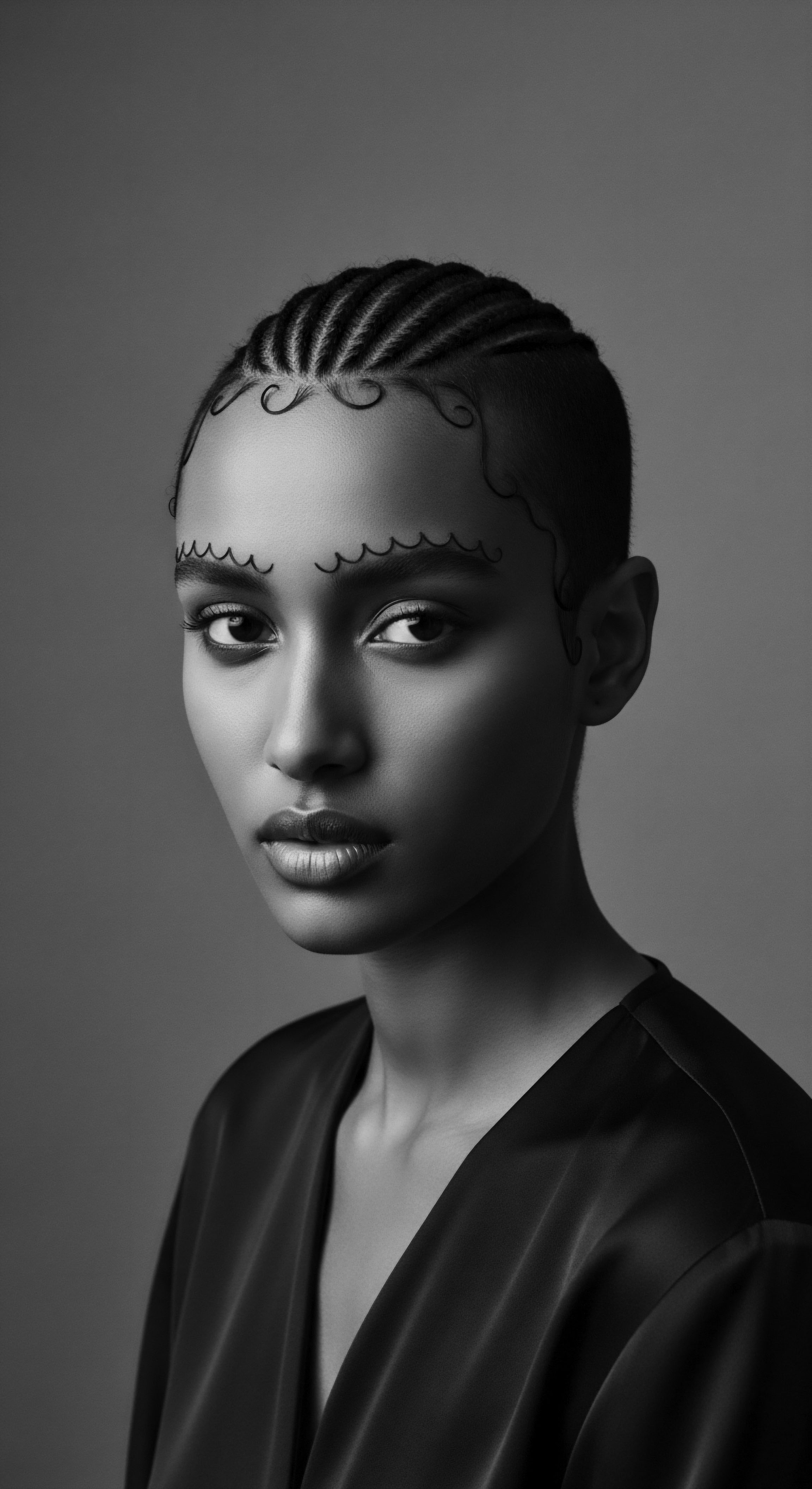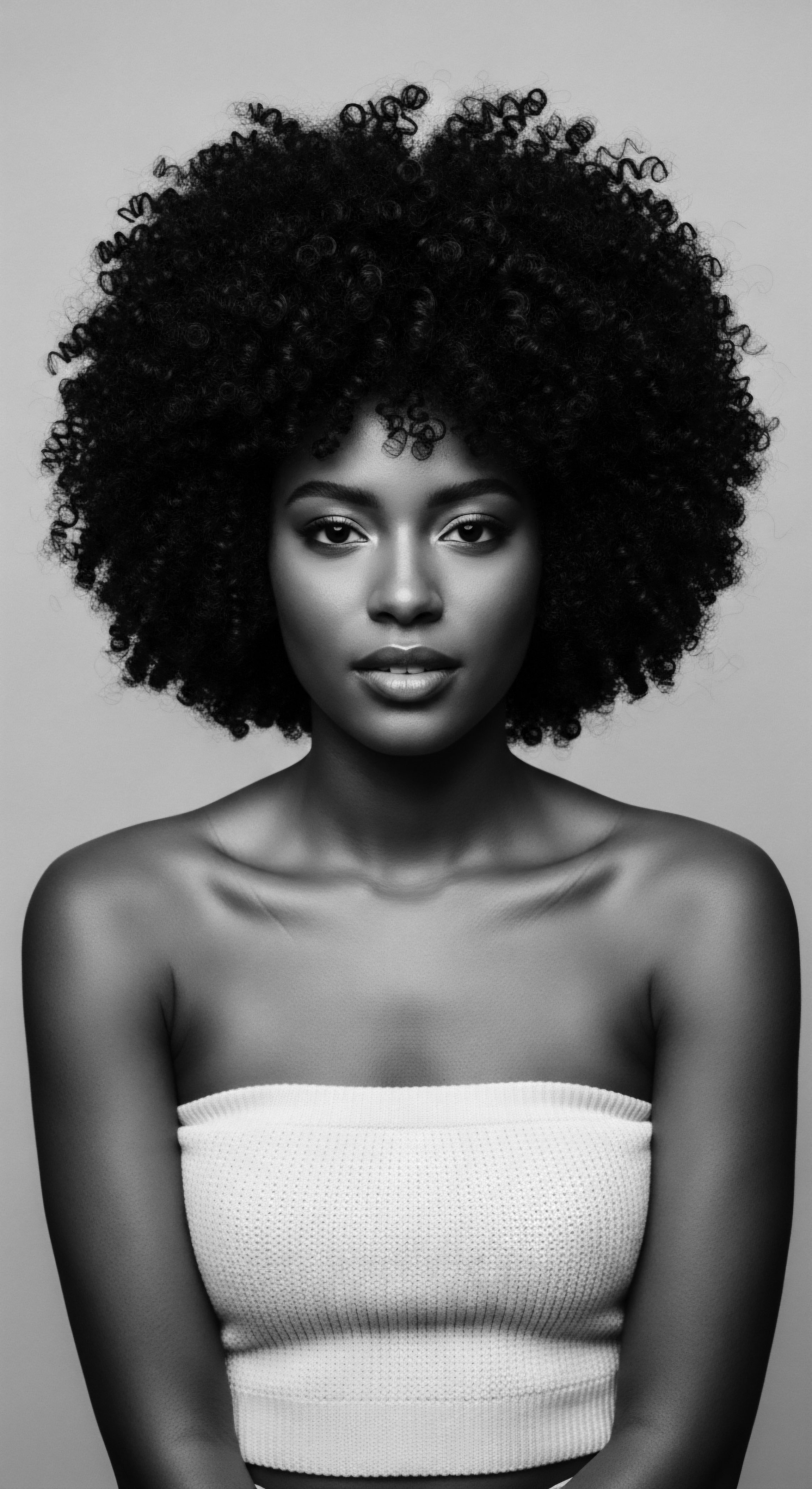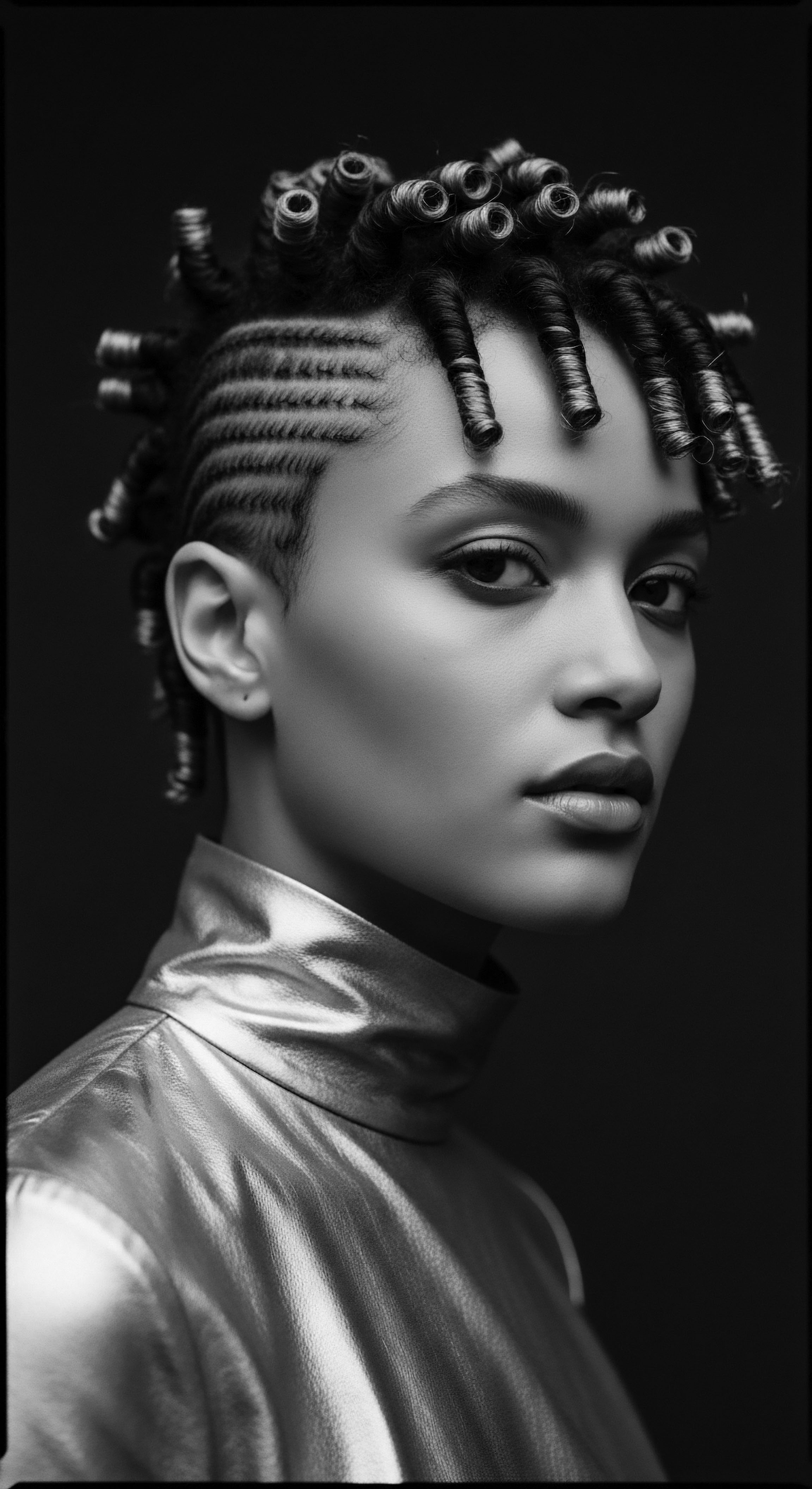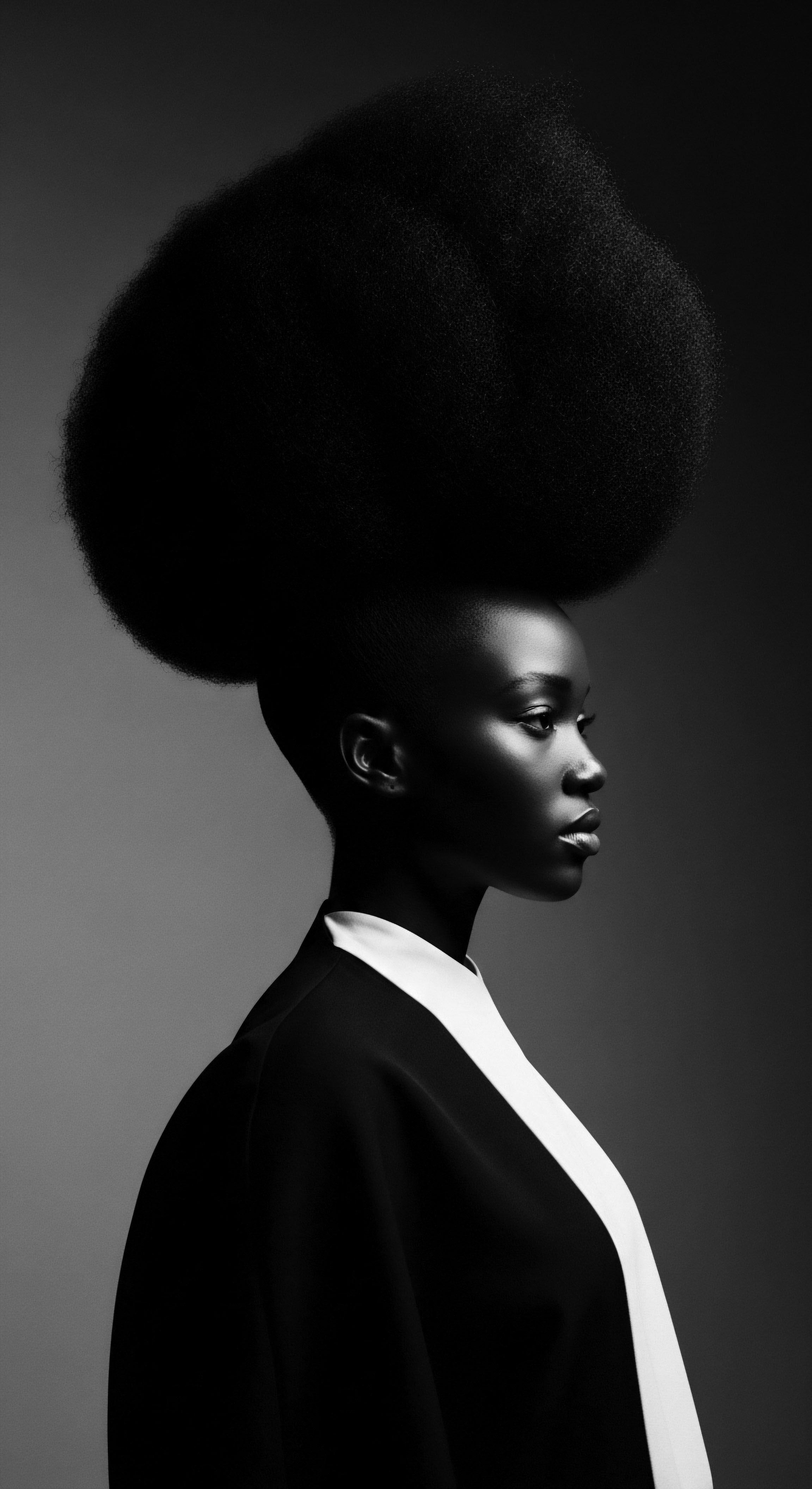
Fundamentals
The intricate dance between identity and tradition finds a profound expression in the very structure of our being, particularly within the textured crown we carry. We begin a contemplation of Osùn Ufie, a concept that reaches into the deepest wells of ancestral wisdom, unveiling a specific understanding of textured hair. This is not a mere descriptor of hair type or a passing trend.
Instead, Osùn Ufie represents the inherent spiritual vitality, the cultural resonance, and the biological fortitude deeply intertwined with hair, particularly within Black and mixed-race communities. It speaks to a legacy of profound knowledge, a resilience woven into each individual strand, and the enduring heritage of care practices passed through generations.
At its fundamental interpretation, Osùn Ufie embodies a recognition of hair as a living, energetic extension of the self, imbued with spirit and history. In many West African traditions, especially within the Yoruba cosmology, the head, known as Orí, carries immense spiritual significance. It is considered the seat of one’s destiny, personal consciousness, and inner divinity (Fáọ̀báre, 2022).
The connection between hair and this concept of Orí is seamless; hair is thus seen not merely as an adornment, but as a direct channel to spiritual well-being and ancestral connection. Osùn Ufie, in this light, encapsulates this sacred relationship, asserting that the care and presentation of textured hair are acts of reverence for one’s inherent power and lineage.
To comprehend Osùn Ufie requires moving beyond superficial aesthetics to a deeper appreciation of the biological and spiritual confluence. The very coil of textured hair, often viewed through narrow Western lenses as something to be ‘managed’ or ‘straightened,’ is instead celebrated as a natural manifestation of unique biological design. Each curl, each twist, carries genetic memory. This physical reality becomes a canvas for spiritual and cultural expression.
The care rituals associated with Osùn Ufie are therefore not solely about physical maintenance; they are acts of tending to one’s spiritual heritage, of honoring the path trodden by those who came before. These practices uphold the significance of a holistic approach to hair, acknowledging its place within the broader spectrum of health and well-being.
Osùn Ufie reveals textured hair as a vibrant repository of spiritual energy and ancestral memory, necessitating care rituals rooted in profound reverence.
The designation of Osùn Ufie signals an invitation to reconnect with the elemental biology that shapes textured hair, understanding its inherent patterns and needs, not as deficiencies, but as distinct strengths. Ancient practitioners, though lacking modern scientific terminology, possessed an intuitive grasp of how specific natural ingredients interacted with hair. They understood the necessity of moisture, the protective qualities of certain styles, and the benefits of gentle manipulation.
This ancestral understanding forms a core pillar of Osùn Ufie’s meaning, providing a timeless framework for nurturing textured hair. It offers a path to rediscovering the inherent balance between hair’s natural inclinations and thoughtful human interaction.

Echoes from the Source ❉ Hair’s Elemental Biology and Ancient Practices
The journey into Osùn Ufie begins with a deep listening to the whispers of our hair’s origins, an exploration of its elemental biology and the ancient practices that honored it. Textured hair, in its myriad forms—from loose waves to tightly wound coils—is a marvel of natural engineering. Its elliptical follicle shape creates the characteristic curl, a design that necessitates a distinct approach to moisture retention and structural integrity.
This anatomical reality, which modern science elucidates, finds resonance in age-old traditional care. Our forebears, through centuries of observation and communal wisdom, understood the subtle requirements of these hair types, devising practices that worked in harmony with its intrinsic nature, rather than against it.
Consider the use of natural butters and oils sourced from the land, such as shea butter, palm oil, or various plant infusions. These ingredients, rich in fatty acids and vitamins, were not chosen arbitrarily. They provided a protective barrier against environmental stressors, sealed in hydration, and offered nourishment to the scalp (Ollengo, 2018).
The deliberate application of these substances reflects an early, sophisticated form of hair science, one grounded in a symbiotic relationship with the earth. It demonstrates an understanding of hair not as an isolated entity, but as a part of a larger ecosystem, intrinsically linked to the environment and its bounties.
- Shea Butter ❉ Utilized for its deep moisturizing and protective qualities, particularly in West African communities, shielding hair from sun and dryness.
- Plant Infusions ❉ Herbal preparations, often from indigenous plants, applied for their fortifying, cleansing, or stimulating properties, aligning with holistic wellness.
- Natural Oils ❉ Various oils, including palm and castor, prized for their ability to seal moisture, enhance shine, and aid in detangling, reflecting an understanding of emollients.

The Living Heritage of Care
The heritage of Osùn Ufie extends beyond mere ingredients, encompassing a philosophy of care that transcends generations. Hair practices in many African societies were communal rituals, often performed by skilled practitioners—the Onídìrí in Yoruba culture, for instance—who were highly esteemed within their communities (Essel, 2023). These sessions were opportunities for intergenerational exchange, storytelling, and the reinforcement of social bonds.
They were spaces where knowledge about hair was transmitted, where younger generations learned not only techniques but also the deeper cultural meanings associated with their hair. This collective aspect of care reinforced the idea of hair as a shared heritage, a tangible link to ancestry and community.
The ritualistic aspect of hair care, often imbued with spiritual significance, meant that hair was routinely adorned with beads, cowrie shells, or intricate patterns (Byrd & Tharps, 2001). These embellishments were not simply decorative; they conveyed information about a person’s age, marital status, social standing, or even religious affiliation. The style itself could act as a visual language, communicating complex narratives without uttering a single word (Omotos, 2018). The understanding of Osùn Ufie encompasses this profound communicative power of hair, recognizing it as a medium through which identity, lineage, and cultural values are continuously articulated.

Intermediate
Expanding our understanding of Osùn Ufie involves a deeper consideration of its historical trajectory and its profound implications for identity across the Black and mixed-race diaspora. The meaning of Osùn Ufie, far from being static, reveals itself through the ebb and flow of history, reflecting both periods of profound affirmation and moments of imposed subjugation. This concept is fundamentally tied to the journey of textured hair through various societal landscapes, from its revered status in ancient African kingdoms to its deliberate devaluation during chattel slavery and subsequent colonial eras.
Historically, in numerous African societies, hair was an elaborate form of artistic expression, a testament to spiritual connection, and a social signifier of immense import (Akanmori, 2015). The diversity of hairstyles conveyed complex social codes ❉ a particular braid pattern might signify tribal affiliation, a head adornment could denote marital status, or the length and texture of hair might indicate a person’s age or rank. Osùn Ufie, in this context, highlights the intrinsic value placed on textured hair as a communicative medium, a living archive of community narratives and individual journeys. The intentional sculpting of hair was an act of profound cultural literacy, a means of expressing belonging and identity.
Osùn Ufie represents the continuous struggle and triumph of textured hair as a symbol of identity, resilience, and cultural continuity across generations.
The transatlantic slave trade, however, initiated a brutal disruption of this rich heritage. The forced shaving of heads upon arrival in the Americas was a calculated act of dehumanization, designed to strip enslaved Africans of their cultural identity and sever their connection to ancestral practices (Byrd & Tharps, 2001). This traumatic erasure marks a devastating chapter in the story of Black hair.
The subsequent imposition of Eurocentric beauty standards—where straight, fine hair was deemed desirable—created a long-lasting psychological burden. Osùn Ufie, through the lens of this history, therefore encompasses the resilience demonstrated by communities who, despite immense pressure, found clandestine or subtle ways to maintain elements of their hair heritage, a quiet act of resistance.

The Tender Thread ❉ Living Traditions of Care and Community
The enduring spirit of Osùn Ufie breathes life into the living traditions of care and community that have sustained textured hair heritage through epochs of adversity. The term speaks to the generational transfer of intimate knowledge about hair, from mother to daughter, elder to youth, creating a continuous thread of wisdom. These were not simply technical lessons; they were lessons in self-acceptance, in the inherent beauty of one’s natural form, and in the power of communal bonding. The ritual of hair-dressing, whether in a family home or a community salon, transformed into a sacred space, a sanctuary where stories were shared, burdens lightened, and identities affirmed.
Consider the sheer ingenuity and adaptive spirit of Black women, who, despite lacking access to traditional African herbs and tools in the diaspora, developed new techniques and utilized available resources to nurture their hair. The invention of the hot comb by Madame C.J. Walker at the turn of the 20th century, for example, while sometimes viewed as a means to conform, also represented an ingenious entrepreneurial response to hair care needs at the time, providing a means of managing textured hair in an era of limited options (Bundles, 2001).
This adaptation, though complex in its implications, speaks to an enduring drive to care for hair, even under challenging circumstances. Osùn Ufie acknowledges this adaptive spirit, recognizing the constant effort to maintain hair health and cultural expression amidst evolving social pressures.
- Communal Grooming ❉ Hair care often took place in shared spaces, fostering intergenerational learning, social connection, and the reinforcement of cultural identity.
- Resourceful Adaptation ❉ Faced with new environments and limited traditional materials, diasporic communities ingeniously adapted existing resources or developed novel methods for hair maintenance.
- Storytelling through Strands ❉ Hairstyles served as non-verbal communication, conveying narratives of family history, social status, and individual experiences within a community.

Science and Soul ❉ Validating Ancient Wisdom
Modern hair science, in its ongoing discoveries, frequently affirms the long-standing intuitive wisdom embedded within Osùn Ufie. The scientific elucidation of the unique structure of coiled hair, its porosity, and its susceptibility to dryness provides a contemporary lens through which to appreciate the efficacy of traditional practices. For instance, the use of heavy butters and oils, once perhaps dismissed as unsophisticated, is now understood as an effective emollient strategy to seal moisture into a hair shaft with an often raised cuticle, preventing desiccation. The protective styling traditions—braids, twists, and various forms of threading—reduce manipulation and environmental exposure, thereby minimizing breakage and promoting length retention, a scientific validation of practices employed for centuries (Rodgers, 2012).
Osùn Ufie encourages a dialogue between this ancestral knowledge and contemporary scientific inquiry. It recognizes that while modern understanding can dissect mechanisms, the holistic context and cultural reverence often precede and inform effective care. This synergy allows for a nuanced appreciation of hair health, moving beyond a purely clinical view to one that incorporates the emotional, spiritual, and communal aspects of hair care, acknowledging that true wellness considers the entire human experience.

Academic
The academic delineation of Osùn Ufie posits a complex, deeply layered construct representing the ontological and epistemological significance of textured hair within cultures of African provenance and their diasporic manifestations. It is not a singular phenomenon, but rather a dynamic interplay of biological predispositions, historical subjugation, cultural resilience, and spiritual cosmology, collectively shaping the meaning and lived experience of hair. This interpretative framework invites scholarly examination across anthropology, ethnobotany, sociology, and critical race theory, revealing hair as a profound site of identity formation, resistance, and continuity.
Osùn Ufie, in this scholarly context, is a recognition of the inherent agency of hair as a cultural text, capable of articulating complex societal narratives and individual subjectivities. The term compels a rigorous analysis of the mechanisms through which hair operates as a medium for both self-expression and external inscription of power and prejudice.
The conceptual nucleus of Osùn Ufie derives partially from the Yoruba understanding of Orí (the physical and spiritual head) and the associated Orisha Ọ̀ṣun, often linked to concepts of beauty, fertility, wealth, and the sweet waters (Drewal & Drewal, 1987). This spiritual underpinning imbues hair with a vital force, an Àṣẹ (life force or spiritual power), that positions its care beyond mere cosmetic concern into the realm of spiritual hygiene and destiny alignment. The intricate braiding patterns, the deliberate coiffing, the careful application of natural emollients were thus not merely acts of grooming; they were performative rituals designed to honor Orí, to invoke positive spiritual energies, and to signify one’s connection to the divine order. An analysis of these practices, as illuminated by Osùn Ufie, reveals sophisticated systems of knowledge production, transmission, and embodied praxis, challenging reductive interpretations of pre-colonial African societies as lacking complex scientific understanding.
An examination of this phenomenon must also confront the profound rupture instigated by the transatlantic slave trade and subsequent colonial enterprises. The enforced deculturation, epitomized by the systematic shaving of African heads during the Middle Passage, served to dislodge individuals from their ancestral spiritual moorings and communal identity (Byrd & Tharps, 2001). The historical record yields stark evidence of this deliberate cultural violence.
For instance, the deliberate removal of hair was a primary tool in the apparatus of subjugation, stripping individuals of a vital cultural identifier and a connection to their heritage (Gordon, 2018). This act severed a palpable link to the Osùn Ufie, undermining a fundamental aspect of self and community.

The Unbound Helix ❉ Hair as a Voice of Identity and Shaping Futures
The persistence of distinctive Black hair practices despite centuries of oppression is a powerful testament to the resilient spirit inherent in Osùn Ufie. Even in the direst circumstances of enslavement, communities found subtle yet profound ways to preserve and adapt their hair heritage. One compelling historical example that powerfully illustrates the Osùn Ufie’s connection to textured hair heritage and ancestral practices is the ingenious, albeit harrowing, use of hair as a clandestine means of survival during the transatlantic slave trade. Enslaved African women, drawing upon deeply ingrained agricultural knowledge and a profound understanding of their own biological resilience, would intricately braid rice, millet, and other indigenous seeds into their hair before being forced onto slave ships (Carney, 2013, p.
259). These braided patterns, often mimicking the maps or pathways to freedom, served as living granaries. The act of braiding itself, a deeply communal and culturally significant practice in Africa, was transformed into a desperate act of preservation. Upon arrival in the Americas, these concealed seeds became the foundation for establishing sustenance crops, ensuring survival in unfamiliar and hostile landscapes.
This practice, documented by scholars like Judith Carney, reveals hair not merely as an aesthetic feature, but as a dynamic tool of resistance, a biological and cultural container for continuity, and a silent, yet potent, act of defiance against systematic erasure. The hair, therefore, became a literal “Celeiro” or barn (Carney, “Arroz Negro”, 259), carrying the literal and symbolic seeds of future generations’ survival and cultural legacy.
The practice of braiding seeds into hair by enslaved African women stands as a powerful historical testament to Osùn Ufie, transforming hair into a living archive of survival and cultural continuity.
The subsequent journey of Black hair in the diaspora reflects a continuous negotiation with dominant beauty paradigms. From the ‘conks’ and hot-combed styles of the early 20th century, which often represented a forced assimilation, to the resounding affirmation of the Afro in the Civil Rights era, and the contemporary natural hair movement, hair has consistently been a political and cultural battleground (Byrd & Tharps, 2001). Osùn Ufie encourages an academic lens that views these transformations not as monolithic shifts, but as complex responses to socio-political forces, demonstrating the agency of individuals and communities in reclaiming their aesthetic and cultural autonomy.
The ‘natural hair’ movement, for example, is far more than a stylistic preference; it represents a profound re-alignment with the intrinsic qualities of textured hair, a conscious return to an aesthetic rooted in African heritage, and a rejection of Eurocentric beauty standards. This movement, understood through Osùn Ufie, signifies a collective embrace of the hair’s inherent helix, its unbound nature, as a metaphor for liberation and self-definition.
From a scientific perspective, Osùn Ufie prompts inquiry into the unique biomechanical and biochemical properties of highly coiled hair. The helical structure of African hair, characterized by its elliptical cross-section and propensity for twists and turns along its shaft, presents distinct challenges and strengths compared to straighter hair types (Gavazzoni, 2019). The points of curvature along the hair shaft are often areas of structural vulnerability, susceptible to breakage if mishandled.
Yet, this very architecture creates volume and a natural protective density. Research into optimal moisture retention strategies for low-porosity hair, or the biomechanics of tensile strength in tightly coiled strands, directly correlates with and validates centuries of traditional practices that prioritized protective styling and deep conditioning using indigenous fats and oils.
A critical analysis through the lens of Osùn Ufie also examines the sociopsychological impact of hair-based discrimination. The consistent marginalization of textured hair in professional and academic settings, leading to policies like the CROWN Act, underscores the pervasive nature of anti-Black hair bias (Hope, 2020). This discrimination, which often labels natural Black hairstyles as “unprofessional” or “unruly,” directly attacks the spiritual and cultural meaning embedded in Osùn Ufie. The ongoing struggle for hair liberation is therefore a fight for self-determination, for the right to embody one’s full cultural heritage without penalty.

Interconnected Incidences ❉ The Economic Impact of Hair Heritage
Beyond the cultural and biological, Osùn Ufie also compels an investigation into the economic dimensions of textured hair heritage. The historical commodification of Black hair, from the forced use of enslaved labor for wig-making to the rise of beauty empires built on straightening products, presents a complex narrative of exploitation and resilience (Walker, 2008). The Black beauty industry, born out of necessity and ingenuity, became a significant engine of economic empowerment for Black women, providing avenues for entrepreneurship and community wealth-building (Byrd & Tharps, 2001).
Madame C.J. Walker’s pioneering efforts, while controversial in some aspects due to her focus on straightening, undeniably created pathways to economic independence for thousands of Black women.
The contemporary natural hair movement, a resurgence of Osùn Ufie’s core tenets, has spurred a multi-billion dollar industry centered on products and services for naturally textured hair. This economic shift, however, raises new questions about corporate ownership, cultural appropriation, and the equitable distribution of profits within communities of color. Scholarly inquiry into this domain, guided by Osùn Ufie, seeks to understand how economic systems can better serve and uplift the communities whose heritage forms the foundation of this market, ensuring that the financial benefits truly circulate within the ecosystem of Black hair care.
| Aspect of Care Moisture Retention |
| Traditional Practice (Pre-Diaspora) Regular application of unrefined shea butter, palm oil, or other natural plant-based fats. |
| Modern Scientific Insight (Osùn Ufie Perspective) Natural emollients create occlusive barriers, reducing transepidermal water loss and sealing the hair cuticle. |
| Aspect of Care Protective Styling |
| Traditional Practice (Pre-Diaspora) Intricate braids (e.g. cornrows), twists, and wraps, often adorned for cultural expression. |
| Modern Scientific Insight (Osùn Ufie Perspective) Minimizes mechanical stress and environmental exposure, reducing breakage and promoting length retention. |
| Aspect of Care Scalp Health |
| Traditional Practice (Pre-Diaspora) Scalp massages with herbal infusions and natural oils to stimulate blood flow. |
| Modern Scientific Insight (Osùn Ufie Perspective) Stimulates microcirculation, potentially promoting nutrient delivery to hair follicles; certain botanicals possess anti-inflammatory properties. |
| Aspect of Care Cleansing |
| Traditional Practice (Pre-Diaspora) Use of natural clays (e.g. Bentonite), plant-based saponins, or fermented rinses. |
| Modern Scientific Insight (Osùn Ufie Perspective) Gentle cleansers with mild surfactants maintain natural lipid barrier, preventing stripping and excessive dryness. |
| Aspect of Care The enduring wisdom of ancestral hair practices, illuminated by Osùn Ufie, often finds profound validation in contemporary scientific understanding. |
Osùn Ufie, therefore, is an invitation for multi-disciplinary scholarship to deepen our collective understanding of textured hair, recognizing its multifaceted roles in human experience. It is a lens through which to appreciate the profound intellectual contributions embedded in ancestral care systems, to critique historical injustices, and to celebrate the ongoing vitality of a heritage that continues to shape identities and communities globally. The examination of Osùn Ufie offers pathways to more culturally informed approaches in dermatology, product development, and social policy, ensuring that the intrinsic beauty and historical weight of textured hair are revered and protected.

Reflection on the Heritage of Osùn Ufie
The journey into Osùn Ufie has guided us through the profound understanding that textured hair is far more than mere biological filament; it stands as a living testament to heritage, a dynamic archive of ancestral wisdom, and an enduring symbol of resilience. From the elemental biology of its coils, echoing the ancient earth, to the tender communal rituals of care, and its powerful role in voicing identity across time, the story of Osùn Ufie unfolds with a resonant, deeply human cadence. It reminds us that every strand carries within it the echoes of survival, the rhythm of tradition, and the vibrant spirit of those who nurtured it before us.
This conceptual lens compels a continuous dialogue between past and present, between scientific inquiry and intuitive wisdom. The resilience woven into the very structure of textured hair mirrors the resilience of the communities who bear it, a heritage that has navigated centuries of challenge with grace and an unwavering spirit. Honoring Osùn Ufie means recognizing the sacredness of our hair, not as something to be tamed or altered to fit an external gaze, but as a direct connection to a rich lineage of strength, ingenuity, and profound beauty.
It invites us to approach our hair, and indeed ourselves, with a reverence that acknowledges its inherent power, its historical weight, and its boundless capacity for expression. The narrative of Osùn Ufie, therefore, is not merely a definition; it is a profound call to remember, to cherish, and to actively participate in the living, breathing legacy that resides within each curl and coil.

References
- Akanmori, M. A. (2015). Hair Grooming and Hairstyling as a Sociocultural Practice and Identity ❉ The Case of Black African and Black Caribbean Women. Doctoral dissertation.
- Bundles, A. (2001). On Her Own Ground ❉ The Life and Times of Madam C.J. Walker. Scribner.
- Byrd, A. D. & Tharps, L. D. (2001). Hair Story ❉ Untangling the Roots of Black Hair in America. St. Martin’s Press.
- Carney, J. A. (2013). Seeds of Memory ❉ Botanical Legacies of the African Diaspora. In R. Voeks & J. Rashford (Eds.), African Ethnobotany in the Americas (pp. 13-33). Springer.
- Drewal, H. J. & Drewal, M. T. (1987). Gelede ❉ Art and Female Power Among the Yoruba. Indiana University Press.
- Essel, S. (2023). Hair and the African Culture ❉ A Critical Analysis. Academic paper.
- Fáọ̀báre, A. (2022). Orí ❉ The Metaphysics of the Human Head in Yoruba Thought. University of Ibadan Press.
- Gavazzoni, M. (2019). Hair ❉ Its Structure and Function. CRC Press.
- Gordon, M. (2018). Hair in African Cultures ❉ A History of Adornment and Identity. University of Chicago Press.
- Hope, C. (2020). The CROWN Act ❉ Combating Hair Discrimination in America. Legal and Policy Review.
- Ollengo, M. (2018). Traditional and ethnobotanical dermatology practices in Africa. Clinical Dermatology, 36(3), 353-362.
- Omotos, A. (2018). The Significance of Hair in Ancient African Civilizations. Journal of Pan African Studies.
- Rodgers, C. (2012). Textured Hair ❉ A Complete Guide to Caring for Wavy, Curly, and Coily Hair. Black Hair Media Publishing.
- Walker, A. (2008). Madam C. J. Walker ❉ The Making of an American Icon. Houghton Mifflin Harcourt.
